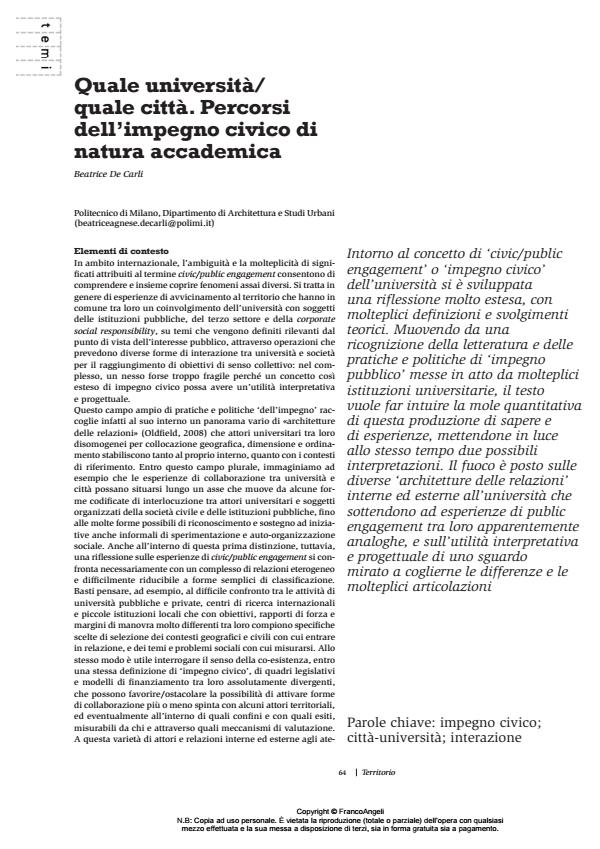Quale università/ quale città. Percorsi dell’impegno civico di natura accademica
Titolo Rivista TERRITORIO
Autori/Curatori Beatrice De Carli
Anno di pubblicazione 2013 Fascicolo 2013/66 Lingua Italiano
Numero pagine 5 P. 64-68 Dimensione file 147 KB
DOI 10.3280/TR2013-066014
Il DOI è il codice a barre della proprietà intellettuale: per saperne di più
clicca qui
Qui sotto puoi vedere in anteprima la prima pagina di questo articolo.
Se questo articolo ti interessa, lo puoi acquistare (e scaricare in formato pdf) seguendo le facili indicazioni per acquistare il download credit. Acquista Download Credits per scaricare questo Articolo in formato PDF

FrancoAngeli è membro della Publishers International Linking Association, Inc (PILA)associazione indipendente e non profit per facilitare (attraverso i servizi tecnologici implementati da CrossRef.org) l’accesso degli studiosi ai contenuti digitali nelle pubblicazioni professionali e scientifiche
Very extensive discussion has developed around the concept of ‘civic/public engagement’ or ‘civic commitment’, with a great variety of definitions and theoretical approaches. The paper starts with a survey of the literature and of the ‘public commitment’ practices and policies currently pursued by many universities and then seeks to convey an idea of the huge quantity of this production of knowledge and experiences, highlighting at same time two possible interpretations. The focus is on the different ‘relationship architectures’ inside and outside universities which underlie public engagement experiences that are apparently similar to each other and also on the usefulness to interpretation and planning of an eye that seeks to grasp the differences and the great variety.;
Keywords:Civic commitment; city-university; interaction
- Bawa A., 2007, «Rethinking The Place of Community-Based Engagement at Universities», in McIlrath L. and Mac Labhrainn I. (eds.), Higher Education and Civic Engagement: International Perspectives, Ashgate, London, pp. 55-65.
- Boland J., 2011, «Positioning Civic Engagement on the Higher Education Landscape: Insights from a Civically Engaged Pedagogy», Tertiary Education and Management, vol. 17, n. 2, pp. 101-115, DOI: 10.1080/13583883.2011.562523
- Butin D.W., 2003, «Of what use is it? Multiple Conceptualizations of Service Learning within Education», Teachers College Record, vol. 105, n. 9, pp. 1674-1692, DOI: 10.1046/j.1467-9620.2003.00305.x
- Castelnuovo I., Cognetti F., 2013, «The Double Responsibility of Public Engagement. Reflections from the Polisocial Program», in Nash E.J., Brown N.C., Bracci L. (eds.), Intercultural Horizons: Intercultural Strategies in Civic Engagement, Cambridge Scholars Press, Cambridge.
- Cornwall A., 2002, «New Democratic Spaces? The Politics and Dynamics of Institutionalised Participation», IDS Bullettin, vol. 35, n. 2, pp. 1-10, DOI: 10.1111/j.1759-5436.2004.tb00115.x
- Cornwall A. and Schattan Coelho V., 2007, Spaces for Change? The Politics of Citizen Participation in New Democratic Arenas, Zed Books, New York.
- Edwards M., 2007, «Love, Reason, and the Future of Civil Society», in McIlrath L. and Mac Labhrainn I. (eds.), Higher Education and Civic Engagement: International Perspectives, Ashgate, London, pp. 13-25.
- Furco A., 2007, «Institutionalising Service-Learning in Higher Education», in McIlrath L. and Mac Labhrainn I. (eds.), Higher Education and Civic Engagement: International Perspectives, Ashgate, London, pp. 65-82.
- Furie M., 2003, «Beyond the Ivory Tower: Service Learning for Sustainable Community Development», South African Journal for Higher Education, vol. 17, n. 1, pp. 31-38.
- Garcia Lamarca M., 2011, «Implementing the Right to the City in Brazil», in Polis – A Collaborative Blog About Cities Across The Globe (thepolisblog.org/2011/10/implementing-right-to-city-in-brazil.html).
- Honnet E.P. and Poulsen S., 1989, Principles of Good Practice in Combining Service and Learning. Wingspread Special Report, Johnson Foundation, Racine, WI.
- Howard J. and McKeachie W., 1993, Praxis: A Faculty Casebook on Community Service Learning, Ocsl Press, University of Michigan, Ann Arbor.
- Jacoby B., 2003, Building Partnerships for Service-learning, Jossey-Bass, San Francisco, CA.
- McIlrath L. and Mac Labhrainn I., 2007, eds., Higher Education and Civic Engagement: International Perspectives, Ashgate, London.
- Negri A., 2003, «Conversation with Charles Guerra», Grey Room, vol. 11, Spring, pp. 86-109.
- Oldfield S., 2008, «Who’s Service Whom? Partners, Process, and Products in Service-Learning Project in South African Urban Geography», Journal of Geography in Higher Education, vol. 32, n. 2, pp. 269-285, DOI: 10.1080/03098260701514215
- Paba G., 2009, «Partecipazione, deliberazione, auto-organizzazione, conflitto », in Paba G., Pecoriello A.L., Perrone C., Rispoli F., Partecipazione in Toscana. Interpretazioni e racconti, Firenze U.P., Firenze, pp. 15-52.
- Watson D., Hollister R., Stroud S.E., Babcock E., 2011, The Engaged University: International Perspectives on Civic Engagement, Routledge, London.
- Wiewel W., Broski D., 1997, University Involvement in the Community. Developing a Partnership Model (web.pdx.edu/~wubbold/EcoImpact08/Partnership%2520model.pdf).
- Young I.M., 2000, Inclusion and Democracy, Oxford U.P., Oxford-New York.
- Ricerca-azione e università. Produzione di conoscenza, inclusività e diritti Francesca Cognetti, in TERRITORIO 78/2016 pp.40
DOI: 10.3280/TR2016-078004
Beatrice De Carli, Quale università/ quale città. Percorsi dell’impegno civico di natura accademica in "TERRITORIO" 66/2013, pp 64-68, DOI: 10.3280/TR2013-066014